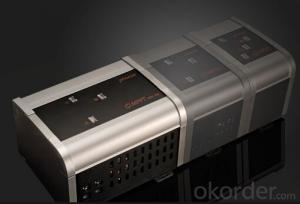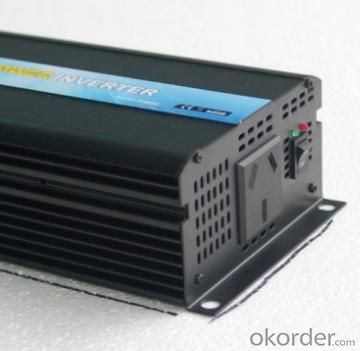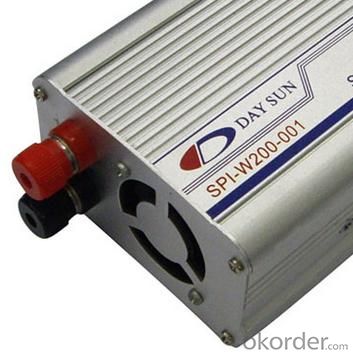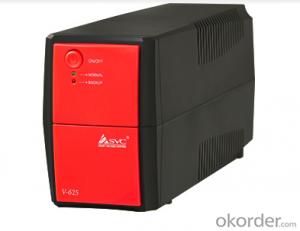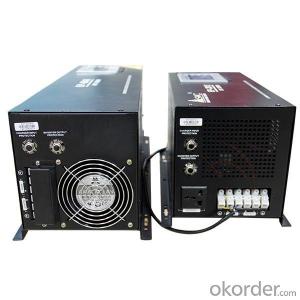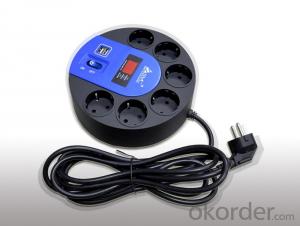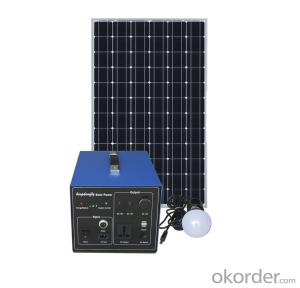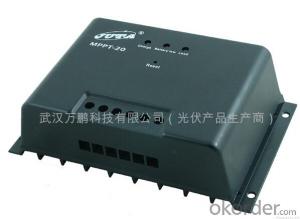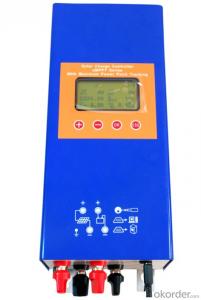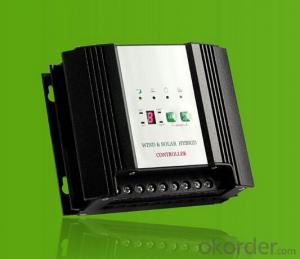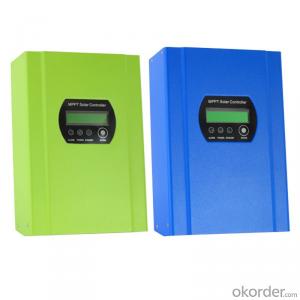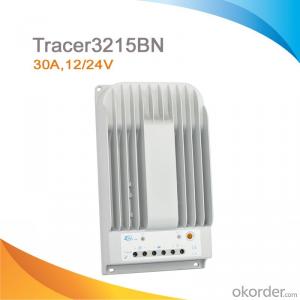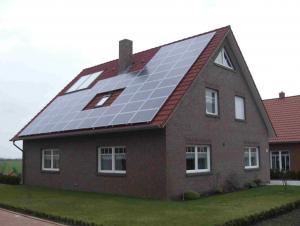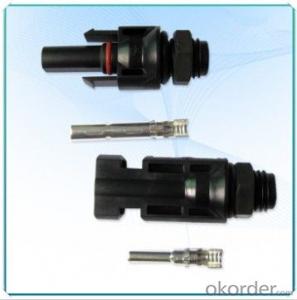Passive and Active Solar Energy Systems Solar MPPT 100/30 (30 A) Maximum Power Point Tracker
- Loading Port:
- China Main Port
- Payment Terms:
- TT or LC
- Min Order Qty:
- -
- Supply Capability:
- 10000 unit/month
OKorder Service Pledge
OKorder Financial Service
You Might Also Like
1, Product desciption
Inverter circuits designed to produce a variable output voltage range are often used within motor speed controllers.
The DC power for the inverter section can be derived from a normal AC wall outlet or some other source. Control and feedback circuitry is used to adjust the final output of the inverter section which will ultimately determine the speed of the motor operating under its mechanical load.
Motor speed control needs are numerous and include things like: industrial motor driven equipment, electric vehicles, rail transport systems, and power tools. (See related: variable-frequency drive ) Switching states are developed for positive, negative and zero voltages as per the patterns given in the switching Table.
The generated gate pulses are given to each switch in accordance with the developed pattern and thus the output is obtained.
2, Features of the product
Inverters convert low frequency main AC power to higher frequency for use in induction heating.
To do this, AC power is first rectified to provide DC power. The inverter then changes the DC power to high frequency AC power. Due to the reduction in the number of DC Sources employed, the structure becomes more reliable and the output voltage has higher resolution due to an increase in the number of steps so that the reference sinusoidal voltage can be better achieved.
· Built-in 1 year data logger for system analysis
· Charge and discharge status display
· Acoustic load disconnect pre-warning
· Load status indication
· Choose between 5 load disconnect algorithms
· Boost/absorption/float PWM-regulation (series type)
· Integrated temperature compensation
· Covered terminals (up to 16 mm2 wire size)
· Full solid-state protection
The first thing to figure out is the length of road in need of street lights.
This can be a small entrance road only a couple hundred of feet long to miles of streets through an area. Does the area currently have any type of lighting available.
What is the reason for needing street lights in this area
Is the electrical grid already nearby or would you need to call in the power company to bring in electrical lines.
If the electric needs to be brought to the area, how much is this going to cost? Depending on how far the grid electric is from the location of the needed lighting, this can be quite expensive.
How much lighting is needed on the street? Do the lights need to be dark sky compliant.
Do the street lights need to run from dusk to dawn or for only a specified number of hours at night.
Are the street lights able to dim in the middle of the night and still provide enough lighting.
These questions need to be answered before you can decide on how many lights you will need to complete the project.
3, Product Image
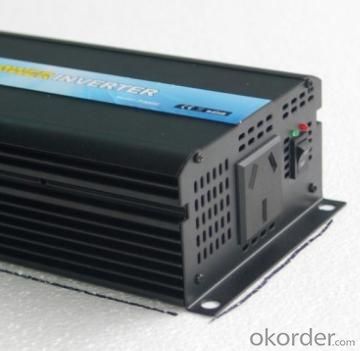
4, Detailed Specification
INPUT | |
Input voltage range | 185~265±5Vac |
OUTPUT | |
Output voltage range | 185~265±5Vac (AC mode) , 230Vac (DC mode) |
Output frequency (DC mode) | 50Hz (48~54Hz) or 60Hz(58~64Hz), same as AC(AC mode) 50Hz ±0.3Hz (DC mode) |
Wave form | Sine wave (DC Mode) |
Transfer time | 10ms. (Typical) |
BATTERY | |
Rated charging current (max.) | 45A |
Norminal DC input voltage | 12V |
Min. DC start voltage | 20V / 40V |
PHYSICAL | |
Unit dimension (mm) | 526*277*212 |
Master box dimension (mm) | 620*350*370 |
Net weight (1pc, kg) | 22.8 |
- Q: Can solar energy systems be installed on multi-story buildings?
- Yes, solar energy systems can definitely be installed on multi-story buildings. In fact, multi-story buildings provide ample rooftop space to accommodate a larger number of solar panels, which can generate a significant amount of renewable energy. Additionally, the height of the building may even provide better sun exposure for the solar panels, enhancing their overall efficiency.
- Q: Can solar energy systems be used in areas with limited access to solar energy warranties and guarantees?
- Yes, solar energy systems can still be used in areas with limited access to solar energy warranties and guarantees. While warranties and guarantees provide added assurance and protection, the functionality and performance of solar energy systems largely depend on the availability of sunlight. Even in areas with limited access to sunlight, solar energy systems can still generate electricity, although their efficiency and output may be reduced. It is important to consider factors such as the amount of available sunlight, system design, and energy storage options to ensure optimal system performance in areas with limited solar energy warranties and guarantees.
- Q: Can solar energy systems be used in powering community centers or social organizations?
- Yes, solar energy systems can definitely be used in powering community centers or social organizations. Solar energy is a clean and renewable source of power that can provide electricity for various purposes, including lighting, heating, and running electrical appliances. Community centers and social organizations often require a significant amount of electricity to cater to the needs of their members or visitors. By installing solar panels on their rooftops or in nearby open spaces, these organizations can generate their own electricity and reduce their dependence on the traditional power grid. One of the key advantages of using solar energy systems is the cost savings they offer in the long run. While the initial installation costs may be higher compared to conventional power sources, solar panels have a lifespan of 25-30 years and require minimal maintenance. This means that over time, the investment made in solar energy systems can be recovered through reduced electricity bills. Moreover, solar energy systems are environmentally friendly, as they produce zero greenhouse gas emissions during operation. By utilizing solar power, community centers and social organizations can contribute to mitigating climate change and reducing their carbon footprint. Solar energy systems can also provide a reliable source of electricity, especially in areas where power outages are common. By integrating battery storage systems, excess solar energy can be stored and used during periods of low or no sunlight, ensuring uninterrupted power supply to the community center or social organization. Furthermore, solar energy systems can be an educational tool for social organizations to raise awareness about renewable energy and sustainability. By demonstrating the benefits and feasibility of solar power, these organizations can inspire community members to consider adopting clean energy solutions in their own homes and businesses. In conclusion, solar energy systems are a viable and sustainable option for powering community centers or social organizations. They offer cost savings, environmental benefits, reliability, and educational opportunities. By embracing solar power, these organizations can lead by example and contribute to a more sustainable future.
- Q: What is the impact of roof orientation on the performance of solar panels?
- The efficiency and energy generation of solar panels are greatly affected by the orientation of the roof. The direction in which the roof faces, whether it be south, east, west, or north, plays a significant role. Solar panels perform best when installed on a south-facing roof as it allows them to receive the maximum amount of sunlight throughout the day. South-facing roofs receive direct sunlight for a longer duration, resulting in increased solar energy capture. If the roof faces east or west, the solar panels will still receive sunlight, but their energy generation may be reduced. East-facing roofs receive morning sunlight, which is advantageous in regions with higher morning electricity demand. However, energy production may be lower compared to south-facing roofs, as they do not receive sunlight for the entire day. Similarly, west-facing roofs receive afternoon sunlight, which may be beneficial in areas with higher afternoon electricity demand. North-facing roofs have the least favorable orientation for solar panels. They receive the least amount of direct sunlight, resulting in lower energy generation potential. In regions with predominantly northern orientation, solar panels may not be the most efficient or cost-effective solution for renewable energy generation. Aside from orientation, the tilt angle of the roof also impacts solar panel performance. The ideal tilt angle is typically determined based on the location's latitude. Adjusting the tilt angle can optimize sunlight exposure and maximize energy generation. To ensure optimal energy production and maximize the benefits of solar power, it is crucial to consider the orientation and tilt of the roof when installing solar panels. South-facing roofs offer the highest energy generation potential, while east, west, and north-facing roofs may have varying levels of efficiency.
- Q: Can solar energy systems be used in urban environments?
- Yes, solar energy systems can definitely be used in urban environments. In fact, urban areas can be ideal for solar energy due to the high population density and availability of rooftop spaces. Solar panels can be installed on buildings, homes, and other structures in cities to harness the power of the sun and provide clean and renewable energy. Additionally, advancements in solar technology have made it possible to integrate solar panels into various urban infrastructure, such as streetlights and bus stops, further expanding the use of solar energy in urban environments.
- Q: What is the role of solar energy systems in promoting sustainability?
- Solar energy systems play a crucial role in promoting sustainability by providing a clean, renewable, and abundant source of energy. Unlike fossil fuels, which emit harmful greenhouse gases and contribute to climate change, solar energy systems generate power without producing any pollution or emissions. This not only helps to mitigate the negative impacts of climate change but also reduces the dependence on finite fossil fuel resources, which are rapidly depleting. Solar energy systems also contribute to sustainability by decentralizing energy production. Traditional energy sources, such as coal-fired power plants, are typically large-scale and located far away from the end-users. This results in significant energy losses during transmission and distribution. In contrast, solar energy systems can be installed on rooftops or in close proximity to where the energy is needed, reducing energy losses and improving overall efficiency. Additionally, solar energy systems enable individuals and communities to become more self-sufficient and less reliant on centralized energy grids. By producing their own electricity, households and businesses can reduce their energy bills and have a more stable and reliable energy supply, especially in remote areas or during power outages. This decentralization also helps to enhance energy security and resilience, as it reduces the vulnerability to disruptions caused by natural disasters, cyber-attacks, or other emergencies. Furthermore, solar energy systems have a long lifespan and require minimal maintenance, resulting in lower operational costs compared to conventional power generation technologies. This makes solar power an economically viable option, particularly over the long term. As the cost of solar panels and related technologies continues to decline, more individuals, businesses, and governments are investing in solar energy systems, driving further adoption and creating a positive feedback loop for sustainability. The role of solar energy systems in promoting sustainability extends beyond the environmental and economic benefits. Solar power can also have social implications by providing access to electricity for communities that are currently underserved or lack reliable energy sources. This can improve the quality of life, support economic development, and enable educational opportunities, especially in developing countries. In summary, solar energy systems play an integral role in promoting sustainability by reducing greenhouse gas emissions, improving energy efficiency, enhancing energy security, and fostering economic development. By harnessing the power of the sun, we can create a more sustainable future for generations to come.
- Q: Can solar energy systems be used in areas with frequent lightning strikes?
- Yes, solar energy systems can be used in areas with frequent lightning strikes. However, it is essential to take proper precautions to protect the system from potential damage caused by lightning strikes. This can be achieved by using lightning arrestors, surge protectors, and grounding systems to minimize the risk of electrical surges and ensure the safety and integrity of the solar energy system.
- Q: Can a solar energy system be installed on a retail store or restaurant?
- Yes, a solar energy system can be installed on a retail store or restaurant. In fact, many businesses are opting for solar installations to reduce their energy costs and carbon footprint. With advancements in technology and flexible installation options, it is feasible to harness solar power even in urban areas.
- Q: How much does it cost to install a solar energy system?
- The cost of installing a solar energy system can vary depending on several factors such as the size of the system, location, and specific project requirements. On average, residential solar installations can cost anywhere between $15,000 to $25,000 or more. However, it's important to note that there are also various financial incentives, tax credits, and financing options available that can help offset the initial cost and make solar energy more affordable for homeowners and businesses.
- Q: How do solar energy systems store excess energy?
- Solar energy systems store excess energy through the use of batteries or other energy storage technologies. This allows the surplus energy generated by the system during periods of high sunlight to be stored and used later when sunlight is not available, such as at night or during cloudy days.
Send your message to us
Passive and Active Solar Energy Systems Solar MPPT 100/30 (30 A) Maximum Power Point Tracker
- Loading Port:
- China Main Port
- Payment Terms:
- TT or LC
- Min Order Qty:
- -
- Supply Capability:
- 10000 unit/month
OKorder Service Pledge
OKorder Financial Service
Similar products
Hot products
Hot Searches
Related keywords
